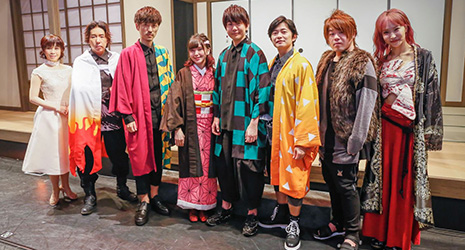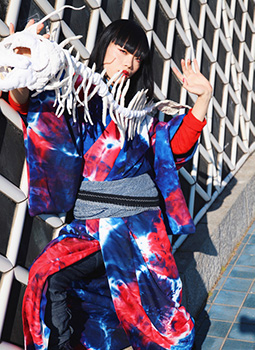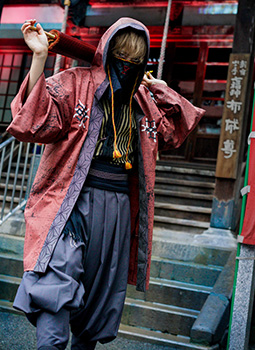INDEX
- English
- 日本語

The cast in costume for a Demon Slayer: Kimetsu no Yaiba anime special event - English
- 日本語

Models wearing kimono styled by KISABURO

Kimono designer KISABURO 

Models wearing kimono designed and styled by KISABURO 
MAYOKE PROJECT by KISABURO
July 2020
Kimono Without Borders

Tokyo is a city that continues to attract the attention of the global fashion industry, in particular for its innovative and sometimes extreme street fashion. Recently, a young designer of kimono has been catching the eye in this ever-changing contemporary fashion world.

Kimono, the traditional clothing of Japan, has a global reputation for being elegant and sophisticated. KISABURO, a 4th-generation kimono designer at Iwamoto Kimono Making, a kimono tailor in Tokyo with 98 years of history, is garnering attention for reinterpreting the kimono aesthetic.
Demon Slayer: Kimetsu no Yaiba, a manga and anime set in the Taisho period (1912–1926) in which the protagonist fights against the demons who killed his family, is currently popular among young people in Japan. KISABURO is in charge of costume design for events. Through communicating the appeal of kimono, KISABURO has come to attract lots of attention even among those who are not fans of the manga series. “I aimed to faithfully reproduce the kimono from the series as much as possible. I felt I could make beautiful kimono by hand-sewing the artwork into gentle silhouettes,” KISABURO states.
The theme of KISABURO’s brand, launched in 2015, is “Going Beyond Borders”. The brand name suggests enjoying kimono freely, going beyond the borders of Western and Japanese styles or standard styles for men and women, for example. These kimono can be enjoyed in a stylish way, subverting conventional ideas about how or where kimono should be worn.
“It’s really cool to wear kimono correctly,” says KISABURO. “But, I also think it’s cool to wear kimono in a rough kind of way, such as over everyday Western clothing, and feel free to stroll around areas of Tokyo with high-rise buildings, for example.”



The name KISABURO was passed down from the designer’s late great-grandfather, an innovative kimono maker in the Meiji period (1868–1912). KISABURO says, “Looking back on my childhood, though I was born as a girl, from a young age, I hated being made to wear floral patterns and other kimono for girls. Because of this, I didn't really feel attached to my family business. I didn’t really understand the attachment to kimono that my family’s business had.”
That all changed when KISABURO borrowed and wore a family-designed (grandfather) kimono for the Tama Art University graduation ceremony. KISABURO’s father, who hadn’t previously sought to pass on the family business to KISABURO, talked in detail about kimono for the first time, and KISABURO recognized the appeal of kimono.
“Kimono are cut in a straight line and finished without leaving any remaining cloth, and they are a sustainable type of clothing that can be remade by simply loosening the stitches. My grandfather lived in very different times from me and his body shape was quite different, but I can wear the same kimono, overcoming those differences. Learning of this rational beauty, I came to like kimono.”
As a new and recent experiment, KISABURO hosted RUSU NI SURU, a contactless online communication project in July of this year. For this project, participants write and send in what they are afraid of—for example, “infectious disease”—along with their own actual clothing, and a talisman pattern will be designed for the clothing by KISABURO’s own hand and sent back to the participant. The production process was streamed online at the “KOKO NI IRU” (“I am here”) event held on August 7.

“During epidemics in the past, people turned to talismans for inspiration, and from that I came up with this idea. Actually, talismans have long been a design motif in kimono, expressed in the pattern on the kimono itself and on the obi [the sash worn around the waist over the kimono]. For example, parts of the se-mon (crest on the back) of a kimono serve as ‘eyes’ to ward off evil spirits,” KISABURO says.
There are many Japanese people today who don’t know the meanings of the talismans incorporated into kimono. KISABURO hopes that the number of people interested in kimono will increase by sharing this kind of unknown information from Tokyo, a center for fashion.
Kimono are a treasury of unique Japanese designs, which can be enjoyed in abundance on Coming-of-Age Day in January as young people come and go from the ceremony, and increasing numbers of young people can be seen on the streets wearing kimono at other times as well. When you come across someone in a stylish kimono in Tokyo, look out for the embroidery and patterns, and see if you can work out what the talismanic designs might mean.

